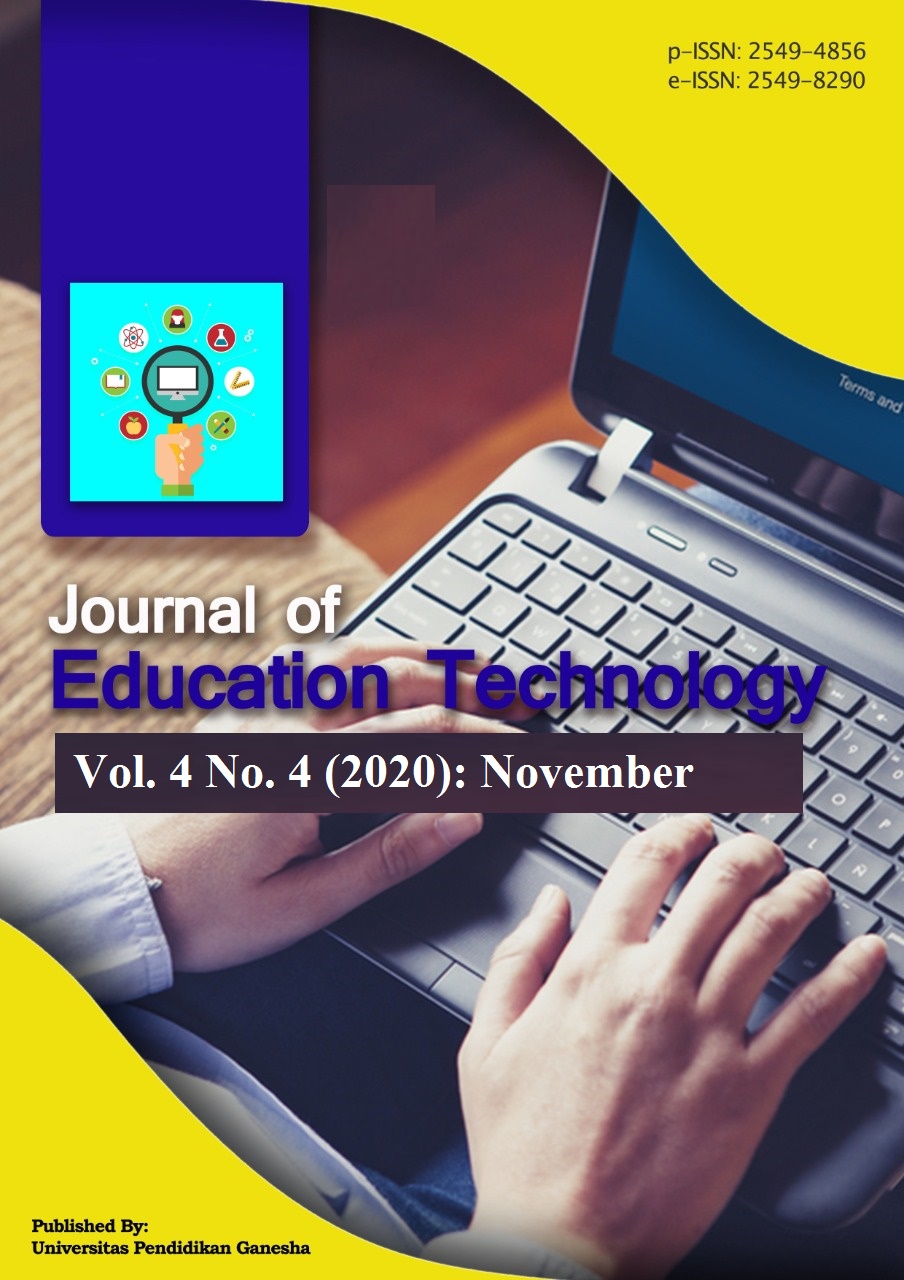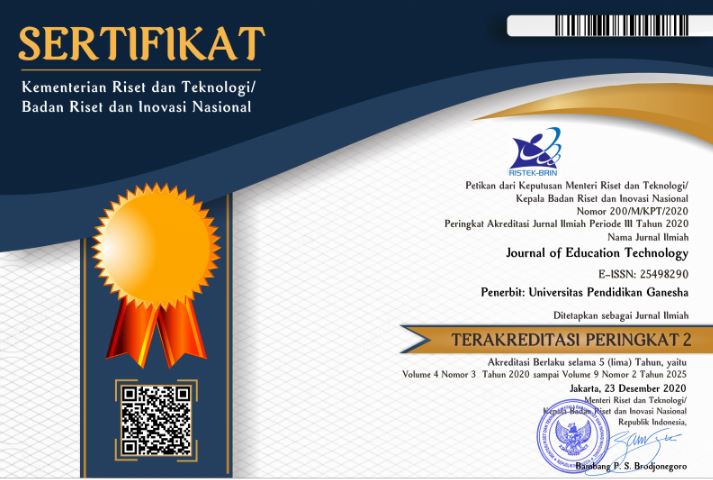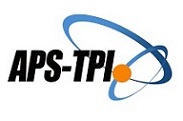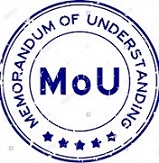The Effect of Connecting, Organizing, Reflecting, Extending Learning Model Assisted by Audio-Visual on Mathematics Learning Outcomes
DOI:
https://doi.org/10.23887/jet.v4i4.27109Keywords:
core, audio visual, mathematics learning outcomesAbstract
This study aims to determine the effect of the Connecting, Organizing, Reflecting, extending (CORE) learning model assisted with audio-visual media on fourth-grade students' mathematics learning outcomes. The type of research is a quasi-experimental research design with a post-test only control group design. The population used in this study was the fourth-grade, with the samples used were IVB class with 34 students as the experimental group and IVA class with 36 students as the control group. The data collection method used is a test method with multiple choice objective test instruments. The obtained data is analysed by using descriptive statistical analysis and inferential analysis. The analysis results obtained were the average score in the experimental group given with the treatment of the CORE learning model assisted by audio-visual media amounted to 21,91. The control group that was not given the CORE learning model's treatment assisted by audio-visual media amounted to 14,00. The t-test analysis obtained count 21,547 and table 2,000 with db. = 68 at a significance level of 5%. With the criteria, count> table so that H0 is rejected and H1 is accepted. The difference scores between the experimental and control groups indicate that there is a significant influence in applying the CORE learning model assisted with audio-visual media in the mathematics learning outcomes of fourth-grade students.
References
Agustini, P. P., Kristiantari, M. . R., & Putra, D. K. N. S. (2016). Penerapan Model Pembelajaran Berbasis Masalah Berbantuan Media Audio Visual Untuk Meningkatkan Hasil Belajar Keterampilan Menyimak Tema Sejarah Peradaban Indonesia Pada Siswa Kelas V Sdn 8 Sumerta. MIMBAR PGSD Undiksha, 4(1). https://doi.org/10.23887/jjpgsd.v4i1.7265
Anggoro, B. S. (2015). Pengembangan Modul Matematika Dengan Strategi Problem Solving untuk Mengukur Tingkat Kemampuan Berpikir Kreatif Matematis Siswa. Al-Jabar: Jurnal Pendidikan Matematika, 6(2), 121–129. https://doi.org/https://doi.org/10.24042/ajpm.v6i2.25
Beniasih, N. M. A., Suarjana, I. M., & Rati, N. W. (2015). Pengaruh Model Pembelajaran Core Berbantuan Media Konkret terhadap Hasil Belajar IPA Siswa Kelas V SD. E-Journal PGSD Universitas Pendidikan Ganesha Jurusan, 3(1), 1–11.
Coleman, B. D., & Fuoss, R. M. (1955). Quaternization Kinetics. I. Some Pyridine Derivatives in Tetramethylene Sulfone. Journal of the American Chemical Society, 77(21), 5472–5476. https://doi.org/10.1021/ja01626a006
Farib, P. M., Ikhsan, M., & Subianto, M. (2019). Proses berpikir kritis matematis siswa sekolah menengah pertama melalui discovery learning. Jurnal Riset Pendidikan Matematika, 6(1), 99–117. https://doi.org/10.21831/jrpm.v6i1.21396
Hidayati, N., & Roesdiana, L. (2019). Meningkatkan kemampuan koneksi matematik mahasiswa melalui model pembelajaran CORE dengan metode diskusi. Jurnal Penelitian Pendidikan Matematika Dan Pengajaran Matematika, 4(1), 31–34. https://doi.org/https://doi.org/10.37058/jp3m.v5i1.645
Intan, F., & Hidayat, W. (2018). Hubungan Antara Keaktifan Belajar Siswa Terhadap Kemampuan Komunikasi Siswa SMK. Jurnal Visipena, 10(2), 1–15.
Kahar, M. S. (2017). Analisis Kemampuan Berpikir Matematis Siswa SMA kota Sorong terhadap Butir Soal dengan Graded Response Model. Tadris: Jurnal Keguruan Dan Ilmu Tarbiyah, 2(1), 11. https://doi.org/10.24042/tadris.v2i1.1389
Konita, M., & Sugiarto, R. (2017). Analysis of Students Ability on Creative Thinking Aspects in terms of Cognitive Style in Mathematics Learning with CORE Model Using Constructivism Approach. Unnes Journal of Mathematics Education., 6(1), 63–70. https://doi.org/10.15294/ujme.v6i1.12496
Kurniawati, I. D., & Nita, S. (2018). Media Pembelajaran Berbasis Multimedia Interaktif Untuk Meningkatkan Pemahaman Konsep Mahasiswa. DOUBLECLICK: Journal of Computer and Information Technology, 1(2), 68. https://doi.org/10.25273/doubleclick.v1i2.1540
Lestari, I. D., Halimatusha’diah, & Puji Lestari, F. A. (2018). Penggunaan Media Audio, Visual, Audiovisual, dalam Meningkatkan Pembelajaran kepada Guru-guru. Jurnal PkM Pengabdian Kepada Masyarakat, 1(01), 55. https://doi.org/10.30998/jurnalpkm.v1i01.2361
Luawo, M. I. R., & Nugroho, I. T. (2018). Media Komik untuk Mengembangkan Pemahaman Kemandirian Emosional Siswa Kelas XI SMA Negeri 111 Jakarta. INSIGHT: Jurnal Bimbingan Konseling, 7(2), 121–132. https://doi.org/10.21009/insight.072.01
Mardiana, M., Deswita, H., & Isharyadi, R. (2020). Pengaruh Model Pembelajaran CORE (Connecting, Organizing, Reflecting, Extending) Terhadap Kemampuan Koneksi Matematis Siswa Kelas VIII SMP N 3 Rambah. Jurnal Absis : Jurnal Pendidikan Matematika Dan Matematika, 2(2), 180–187. https://doi.org/10.30606/absis.v2i2.390
Noka, S. A. N., Said, H. B., & Defitriani, E. (2019). Perbandingan Kemampuan Koneksi Matematis Siswa Melalui Model Pembelajaran Conecting Organizing Reflecting Extending (Core) Dengan Model Pembelajaran Konvensional Di Kelas Viii Smp Negeri 15 Kota Jambi. PHI: Jurnal Pendidikan Matematika, 3(1), 12. https://doi.org/10.33087/phi.v3i1.57
Nurfauziah, I., Nuryani, P., & Fitriani, A. D. (2019). Penerapan Pendekatan RME Untuk Meningkatkan Hasil Belajar Siswa. Jurnal Pendidikan Guru Sekolah Dasar, 4(1), 388–397. https://ejournal.upi.edu/index.php/jpgsd/article/viewFile/20659/10385
Prasetyo, T. I., Syaban, M., & Irmawan. (2018). Pengaruh Penerapan Model Pembelajaran Connecting, Organizing, Reflecting, Extending (CORE) Terhadap Peningkatan Kemampuan Koneksi Matematis Siswa SMA. Jurnal Pendidikan Dan Pembelajran Matematika, 3(1), 1–7. http://jurnal.fkip.unla.ac.id/index.php/intermathzo/article/view/279?articlesBySameAuthorPage=1
Sabrina, R., Fauzi, & Yamin. (2017). Faktor-Faktor Penyebab Rendahnya Motivasi Belajar Siswa Dalam Proses Pembelajaran Matematika Di Kelas V Sd Negeri Garot Geuceu Aceh Besar. Jurnal Ilmiah Pendidikan Guru Sekolah Dasar, 2(4), 108–118. http://www.jim.unsyiah.ac.id/pgsd/article/download/7736/3350
Setiawan, A. D., & Bezaleel, M. (2019). Perancangan Film Pendek “Bukan Hak-Ku” untuk Menanamkan Nilai Kejujuran pada Anak Usia 8-12 Tahun. ANDHARUPA: Jurnal Desain Komunikasi Visual & Multimedia, 5(01), 127–140. https://doi.org/10.33633/andharupa.v5i01.1873
Sirait, E. D. (2016). Pengaruh Minat Belajar Terhadap Prestasi Belajar Matematika. Formatif: Jurnal Ilmiah Pendidikan MIPA, 6(1), 35–43. https://doi.org/10.30998/formatif.v6i1.750
Suta Widura, I. D. G. (2018). Pengaruh Model Core Berbantuan Media Visual Terhadap Hasil Belajar Ipa. Journal for Lesson and Learning Studies, 1(3), 258–267. https://doi.org/10.23887/jlls.v1i3.15390
Sutamin, N. W. (2019). Penggunaan Model Pembelajaran Small Group Work ( SGW ) Dengan Media Audio Visual Untuk Meningkatkan Prestasi Belajar Bahasa Indonesia. Jurnal Imiah Pendidikan Dan Pembelajaran, 3(2), 181–188. https://ejournal.undiksha.ac.id/index.php/JIPP/article/download/18075/10772
Syadeli, M. (2013). Struktur Kepemilikan, Profitabilitas Dan Ukuran Perusahaan Terhadap Kebijakan Hutang Perusahaan Pemanufakturan Di Bursa Efek Indonesia. Jurnal Manajemen Dan Akuntansi, 2, 79–94.
Thamrin, Y., Rusli, & Bernard. (2019). Efektivitas Penerapan Model Kooperatif Tipe Example Non Example dalam Pembelajaran Matematika Siswa Kelas VII SMP. IMED, 3(1), 92–100.
Triningsih, R., & Mawardi. (2020). Efektivitas Problem Based Learning dan Project Based Learning Ditinjau dari Keterampilan Berpikir Kritis Siswa. Jurnal Riset Pendidikan Dasar, 03(April), 51–56.
Usman, F. A., & Afriansyah, E. A. (2017). Kemampuan Pemahaman Matematis Siswa Melalui Model Pembelajaran Auditory Intellectualy Repetition Dan Problem Based Learning (Studi Penelitian di SMP Negeri 1 CisurupanKelas VII). Jurnal Pendidikan Matematika, 11(1), 68. https://doi.org/http://dx.doi.org/10.22342/jpm.11.1.3890.67-78
Utami, M. T., Koeswati, H. D., & Giarti, S. (2019). Model Problem Based Learning ( PBL ) Berbantuan Media audio Visual Untuk Meningkatkan Keteramoilan Berpikir Kritis Pada Siswa Kelas 5 Sekolah Dasar. MAJU, 6(1), 80–91. https://doi.org/https://www.ejournal.stkipbb
Wardika, W., Ariawan, U., & Arsa, S. (2015). Penerapan Model CORE ( Connecting , Organizing , Reflecting , Extending ) Meningkatkan Hasil Aktivitas Belajar Perakitan Komputer Kelas XTKJ2. JPTE Universitas Pendidikan Ganesha Jurusan Pendidikan Teknik Elektro, 4(1), 1–10. https://doi.org/http://dx.doi.org/10.23887/jjpte.v6i3.20856
Yusantika, F. D., Suyitno, I., & Furaidah. (2018). Pengaruh Media Audio dan Audio Visual terhadap Kemampuan Menyimak Siswa Kelas IV. Jurnal Pendidikan, 3(2), 251–258. https://doi.org/http://dx.doi.org/10.17977/jptpp.v3i2.10544
Downloads
Published
How to Cite
Issue
Section
License
Authors who publish with the Journal of Education Technology agree to the following terms:
- Authors retain copyright and grant the journal the right of first publication with the work simultaneously licensed under a Creative Commons Attribution License (CC BY-SA 4.0) that allows others to share the work with an acknowledgment of the work's authorship and initial publication in this journal.
- Authors are able to enter into separate, additional contractual arrangements for the non-exclusive distribution of the journal's published version of the work (e.g., post it to an institutional repository or publish it in a book), with an acknowledgment of its initial publication in this journal.
- Authors are permitted and encouraged to post their work online (e.g., in institutional repositories or on their website) prior to and during the submission process, as it can lead to productive exchanges, as well as earlier and greater citation of published work. (See The Effect of Open Access)
















